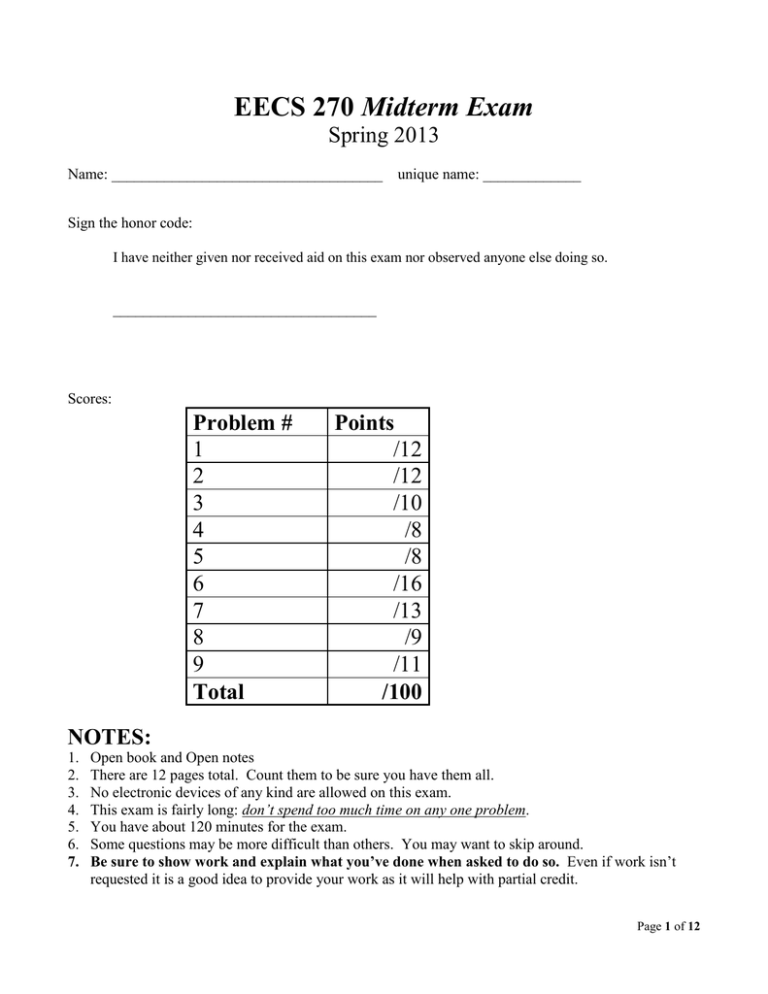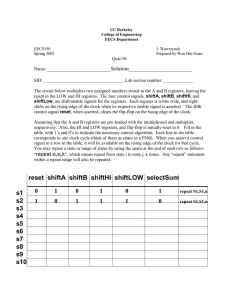Midterm Exam Spring 2013
advertisement

EECS 270 Midterm Exam Spring 2013 Name: ____________________________________ unique name: _____________ Sign the honor code: I have neither given nor received aid on this exam nor observed anyone else doing so. ___________________________________ Scores: Problem # 1 2 3 4 5 6 7 8 9 Total Points /12 /12 /10 /8 /8 /16 /13 /9 /11 /100 NOTES: 1. 2. 3. 4. 5. 6. 7. Open book and Open notes There are 12 pages total. Count them to be sure you have them all. No electronic devices of any kind are allowed on this exam. This exam is fairly long: don’t spend too much time on any one problem. You have about 120 minutes for the exam. Some questions may be more difficult than others. You may want to skip around. Be sure to show work and explain what you’ve done when asked to do so. Even if work isn’t requested it is a good idea to provide your work as it will help with partial credit. Page 1 of 12 1) Fill in each blank or circle the best answer.[12 points, -2 per wrong or blank answer, min 0] a) The 6-bit 2’s complement number representation of -7 is ___________________. b) 11001, when treated as a 5-bit signed-magnitude number, has a decimal representation of __________. c) The range of representation for a 6-bit 2’s complement number is from ______ to ______. d) Consider a memory device that has 2048 addresses each 32 bits in size. If this was made out of a square memory (equal number of rows and columns in the memory device) the row decoder would have _______ inputs while the column MUX would have ________ selection bits. e) A sum-of-products representation of !(A*!B) is ___________________________ f) If you were to represent A+B+C+!D using canonical sum-of-products, there would be ________________ minterms. g) If you were to represent A ⊕ B ⊕ C in canonical product-of-sums form, there would be __________ maxterms. h) A 4-bit 8 to 1 MUX would require _____________ select lines. Page 2 of 12 B D flip-flop D Q C A QB D flip-flop D Q C QB Clock 2) Draw the state transition diagram which is implemented by the above circuit. You should assume the initial state is when both flip-flops are “0”. You should only include states that can be reached from the initial state. Clearly show your work. [12 points] Page 3 of 12 3) Design a state machine which implements the following state transition diagram. Assign state bits S[1:0] as 01 for state X, 11 for state Y, and 10 for state Z. You are to assume that you will never reach the state S[1:0]=00, so you don’t care what happens in that case. You must show your work to get any credit! You only need to compute the next state and output logic, you don’t need to draw the gates or flip-flops! Place your answer where shown, all answers must be in sum-of-products form. [10 points] Input is B. Output is W. W is a “1” in State X and Y (and is “0” in Z). !B !B X Y B !B B B Z (Be sure all are in sum-of-products form!) NS1= __________________________________________ NS0= ___________________________________________ W= ___________________________________________ Page 4 of 12 4) Implement a 1-bit 2 to 1 MUX using only 2-input NOR gates. For full credit, use 4 or fewer NOR gates. Use the inputs and outputs A, B, S and X as shown below. As always, you can freely use Vcc and ground. [8 points, half credit for using more than 4 gates] 2 to 1 MUX A 0 X B 1 S Page 5 of 12 5) Design a state transition diagram that has one input (A) and one output (B). The output should go high and stay high only when A has been high for two cycles in a row and low for two cycles in a row in any order. So inputs of 0011 and 1100 would both cause B to go (and stay) high, as would 00101011 (for example). You are to use as few states as possible. [8 points, 3 are for a minimal answer] Page 6 of 12 Min OR/AND 2ns 1ns NOT 2ns XNOR Max 4ns 1ns 7ns DFF: Clock to Q Set-up time Hold time D flip-flop #1 D Q C Min 2ns Max 3ns 4 ns ??? ns D flip-flop #2 D Q QB C QB D flip-flop #3 D Q C QB Clock 6) Answer the following questions [16 points] a) In order for this circuit to work correctly, what range of values that would be acceptable for the hold time requirement of the D flip-flops? Assume the only options range from 1ns to 10ns. Clearly show your work. [5] Smallest ____________ Largest ____________ b) What is the lowest clock period that could be safely used on this circuit? Clearly show your work. [5] Page 7 of 12 Continued on next page! A c) Say that flip-flop #1’s clock edge always happens 2ns before the clock-edge that goes to flipflops #2 and #3. Would that change your answer to part a, part b, both or neither? Indicate which answers would change and what they would change to. [6] Page 8 of 12 7) Verilog [13 points] a) Complete the following module which is to implement a 2-bit modulo counter. The counter should count in order (0, 1, 2, 3, 0, 1, etc.) if reset is low and enable is high on each rising edge. If reset is high, the output should go to 0 on the next rising edge. If reset is low and enable is low, the output should be held. [6] module counter_2(clock, reset, enable, count); input clock, reset, enable; output [1:0] count; Page 9 of 12 Continued on next page! b) Using the counter you designed on the previous page, complete a Verilog module which implements the following circuit. The output should be the Q[1:0] of counter #2. [7] 2-bit counter #1 Enable Q1 2-bit counter #2 Enable Q1 Reset Reset Q0 Q0 Clock Clock Clock module fun_counter(clock,Q) input clock; output [1:0] Q; Page 10 of 12 8) Consider the circuit diagram below where both counters are modulo counters and the resets are synchronous. Assuming both counters are initially zero, indicate the pattern that will appear out of counter #2. Write your answer using decimal numbers. So, for example, a possible (but wrong) answer would be “0, 1, 2, 1, 1, 3” which indicates that the output would be the pattern 012113012113012113 (etc.) repeating forever. Explain your answer. [9 points] 2-bit counter #1 Enable Q1 2-bit counter #2 Enable Reset Reset Q0 Q0 Clock Q1 Clock Clock Pattern from counter #2: ________________________________ Page 11 of 12 9) Using MUXes [11 points] a) Design a NOT gate using only a 1-bit 2 to 1 MUX. [2] b) Design a 2-input XOR gate using no more than two 1-bit 2 to 1 MUXes. [3] c) Design a D flip-flop using only 1-bit 2 to 1 MUXes. For full credit, you should use as few MUXes as possible. No credit will be given to any answer that uses more than 4 MUXes. [6 points, 3 for being minimal] Page 12 of 12



